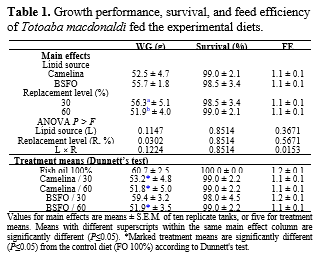REPLACEMENT OF FISH OIL BY CAMELINA AND BLACK SOLDIER FLY LARVAE OILS IN DIETS FOR JUVENILE TOTOABA Totoaba macdonaldi
F ish oil (FO) has been used for decades as the major l ipid source in aquafeed s; it is valued because of the richness in highly unsaturated fatty acids (HUFA), such as docosahexaenoic (DHA, 22:6n-3) and eicosapentae noic (EPA, 20:5n-3) acids, that promote health, growth, and fillet quality of cultured marine organisms . Research on a lternative sources of lipid to replace FO has increased to address sustainability, cost, and availability concerns. Among them, Camelina sativa and Hermetia illucens larvae oil s have been tested in marine fish diets with promising results. Camelina oil contains up to 45% of α- linolenic acid (18:3n-3) and high n-3/n-6 ratio, highly desirable characteristics for an alternative lipid source. B lack soldier fly larvae (BSFL) oil appears to be more palatable or attractable to fis h compared to vegetable oils; it is rich in lauric (12:0) and linoleic (18:2n-6) acids, though th is profile can be improved using substrates rich in omega-3 fatty acids. Totoaba macdonaldi is a newly cultured marine carnivorous fish , endemic to the Gulf of California, Mexico, whose industry is still developing. In the p resent study, the use of camelina and BSFL oils to replace FO in diets for T. macdonaldi was evaluated.
Four isoproteic (51%) and isolipidic (14%) diets were formulated based on a 2×2 factorial design with two lipid sources, camelina and BSFL oils, each tested at two levels of replacement, 30 and 60%. A control diet containing 100% FO as the lipid source was used as a reference . Fish w ith an overall initial mean weight of 3.0 ± 0.1 g were stocked at a density of 100 fish/m3 . Each experimental diet was randomly assigned to five replicate tanks. G rowth performance and feed utilization were evaluated in terms of weight gain (WG) , survival (arcsine square root transformed before analysis), and feed efficiency (FE), among other variables . Proximate composition and fatty acid profile of experi mental diets, muscle, and liver were determined. D ata were subjected to two-way ANOVA (P≤0.05), and Tukey's HSD test was used as the mean separation procedure . In addition, Dunnett's test was used to compare the treatment means to the control mean.
After 7 weeks, fish fed 30% replacement of FO by BSFL oil attained similar growth as fish fed the 100% FO control diet (Table 1). Muscle tissue reflected the fatty acid pro file of the experimental diets; fish fed BSFL oil showed a high content of 12:0 (0.11 mg g−1 of wet tissue ), while 18:3n-3 was higher in those fed camelina oil (0.27 mg g−1 of wet tissue). The fillet of fish fed 30% BSFL oil preserved their nutritional quality, with similar atherogenicity and thrombogenicity indices as the control fish.
Results of this study suggest that 30% of FO can be successfully replaced by BSFL oil in diets for T. macdonaldi without affecting growth and preserving its nutritional value.
